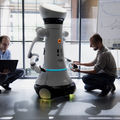Smart Building Technologies and Services

The group was established in 2016 and current research areas are semantics for building systems, user centricity in smart buildings, advanced control systems and smart building rating systems. Research is conducted in close co-operation with companies and associations in the field.
Ongoing research projects
The goal of the project is to 1) study and develop ontologies for describing technical building systems, and 2) research methods for exploiting heterogeneous technical building system semantics in analytics applications such as continuous commissioning and automated fault detection. The research into the use of semantic web technologies for describing technical building systems and querying information about them has led to the development of the Flow Systems Ontology (FSO). On the other hand, the research into enabling analytics with information models expressed with different technologies and structures has led to piloting software architecture that decouples the analytics from the information models with the use of queries.
The research aims in enhancing the building performance and occupant well-being with the help of artificial intelligence tools and internet of things equipment. This includes indoor environment comfort and overall usability for building users and maintenance personnel.
The current research estimates occupant comfort based on various feedback including wearable and other sensor information, questionnaires as well as tools to measure the physiological response of persons. Another strain studies the effects of participating in energy saving schemes to the building occupants. Striking a balance between the energy-savings and well-being is an important aspect in all of the research.
Certain types of neighborhood services are moving closer to consumers and their main competitive advantage is convenience. The proximity of the services mean that citizens can reach many of their daily services on foot or by bicycle and the habit of leaving the car at home can be formed. They are inexpensive to open in empty commercial spaces and inexpensive to run. This allows them to be opened in a very small locality such as on a 500m -800m grid in an urban environment. This study focuses on smart building spaces which we call hyper-local service platforms.
The hyper-local services promise their customers that they will save them time, that they can reach them without a car and that they might bump into their neighbours while doing so. Reducing the need for a car means that the customers can reduce their environmental impact and get more exercise. Spending more time close to home also creates community bonds which improves mental health and reduces loneliness. These services are even more relevant now that knowledge workers are spending more time in their home neighbourhood as a result of increased remote working due to Covid-19.
This research concentrates on end user applications in smart buildings. In our research we call them smart workplace solution (SWS). Typical features of these applications include booking, showing free spaces, occupancy tracking, wayfinding and searching. Our interview studies indicate that from the employer's perspective most important features are related to space development, maintenance, and information to occupants.
The aim of this project is to optimize lighting energy consumption in such ways that user satisfaction is not compromised. The studied control methods include for example: wireless control, daylight-linked control, and occupancy-based control. Furthermore, the possibilities to utilize lighting occupancy data in other building automation systems is explored. Participating organization of the project is Helvar Oy Ab.
Smart readiness indicator is based on Energy performance of buildings directive (EPBD). The SRI will raise awareness of the benefits promised by smart building technologies, such as building automation and electronic monitoring of building systems including heating, hot water, ventilation, lighting, etc. Our group has been involved in developing and testing the calculation method of SRI. We have also investigated how the SRI calculation is applicable to Finnish building design. This research has been made both master and doctoral levels.
Past research projects
The aim of the project was to find common methods to share a data between building systems and IT systems. The project got funding from KIRA-digi, which was one of the key project of Finnish Government. Duration of the project was from December of 2016 to November of 2017. Participating organizations of the projects were Granlund Oy, City of Helsinki, Senate Properties, Helvar Oy, and Tieto Oyj. The project was divided to steps as below:
- A State-of-the-art review and expert interviews of open communication interfaces and semantic data models of building systems
- Open workshop for studying communication interface possibilities
- Piloting of potential interfaces and sematic data models
- National recommendations of communication methods
- An open workshop of outcome of the project
The project created a foundation to new solutions that utilize building measurement data. The project also gave specifications to building owners for the procurement of open building systems. In addition, organizations were able to exploit the outcome of the project in their device, software, and service development.
The project focused on investigating the optimal activation of demand response (DR) methods during a DR event for typical city-owned buildings.
The optimal activation was determined with a building energy simulation software IDA ICE and multi-objective building optimization software MOBO. Optimal demand response action activation were determined with MOBO using variable hourly price rates for supplied energy. The optimization considered all types of energy supplied to the building, i.e. electricity, district heating and district cooling. The results of the optimization were compared to base cases with no demand response to determine potential economic gains for customers and for the energy supplier/producer, resulting from changes in energy consumption and production curves.
The aim of the project was to provide some insight on which demand response actions would be the most beneficial targets to focus on when planning participation in local demand response programs. This was accomplished by establishing a premise for optimal order of activation for several possible demand response actions during a demand response. Variable hourly energy price rates were introduced as means to incentivize the participation to demand response for the customer.
The research aimed to develop prediction models of the building usage and their spaces using machine learning and typical existing data streams from building automation systems (BAS).
The occupant number and usage rate varies significantly between office buildings. Moreover, the space usage divides unevenly within buildings. The building usage information rarely exists without to mention the usage forecast. A building usage highly affects in user comfort, indoor environment quality, maintenance costs and energy consumption. Usage information and the forecast can help to understand user needs better, improve user satisfaction, increase space efficiency and allocate maintenance resources.
Even now, numerous buildings are of sufficiently modern type that include several sensors measuring indoor conditions and the HVAC device operation. By using this data and machine learning, it is possible to estimate the space usage. Furthermore, usage information enables creating a prediction model that uses occupant history and other relevant data. These methods facilitate to predict usage with greatly less cost and more private than with, for example, separate camera based systems that purpose is in occupant calculation.
The research aimed to develop machine learning and data based prediction model for building usage. The research studied the viability of BAS data for building usage prediction and the prediction model accuracy. The study was conducted in real building environment with the data collected from real office buildings.
The project tested new smart technology solutions in a pilot environment in Otaniemi. The building services that were integrated included ventilation, lighting heating and building automation. Multiple sensors were also installed into the spaces and they were used to collect information about various environmental aspects, such as carbon dioxide concentrations and room temperature.
Accelerating digitalization is causing major changes in buildings just like in all other industries. To stay competitive and up to the increasing standards of the end users, the operators in the building and real estate fields of industry must develop smarter solutions. These should improve accessibility, time usage, comfort, well-being of the user and provide experiences.
Achieving this requires collaboration of the various building service systems, Internet of Things solutions, user friendly user interfaces, data analytics and self-learning control solutions. These areas of smart building services were the focus of this project.
Following companies and organizations were involved in the project: Beckhoff, Caverion, Fidelix, Granlund, Helvar, KNX Finland ry and its affiliates, KT Interior, Mirasys, NCC, Schneider-Electric, Siemens, Swegon, Connected Finland, Soficta and Flexitila.
Doctoral school of smart buildings operates in connection with the research group. It provides funding for post-graduate studies and offers opportunity for collaboration with companies in real estate and construction sector. The doctoral school has been made possible by a five-year donation by Center for Electrical Engineering and Energy Efficiency (STEK), Electrical Contractors’ Association of Finland (STUL), Finnish Electrotechnical Trade Association (STK), K.V. Lindholm Foundation, Kiinteistösäätiö, Finnish Association of Civil Engineers (RIL), Granlund, Helvar, Ramboll and Caverion.
The group’s personnel are:


Everyday choices: Ken Dooley, what makes a building smart?
This professor of practice wants to solve frustrating problems with simple tools.

Smart buildings make life easier and use less energy
In a smart building, the lighting system learns how occupants move throughout the building, transport robots talk to lifts, and users are guided to available workspaces by a mobile app. A new doctoral school at Aalto University is set to boost development in the field of smart buildings.

Saving energy with smart building services engineering
The donation for the teaching and research in smart building services engineering and smart buildings has accelerated the development of the field and inspired new students.

Additional donations towards smart building services engineering
The role of smart buildings will grow further in the breakthrough brought about by renewable energy and digitalisation.

Solutions for buildings through smart building services engineering
Aalto University gets a donation of over a million euros for the development of education and research into smart building technology and smart buildings.







